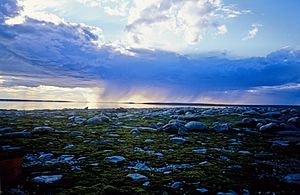Utkuhiksalingmiut facts for kids
The Utkuhiksalingmiut are an Inuit group from Nunavut, Canada. Their name means "the people of the place where there is soapstone". They are one of 48 different Inuit groups living in Nunavut today.
Their traditional home was around the Chantrey Inlet area, near the Back River. This area was once part of the Keewatin District in the Northwest Territories. The Utkuhiksalingmiut lived a traditional life, moving with the seasons to hunt and fish. They would fish near the mouth of the Back River in Chantrey Inlet. Then, they would move to the Garry Lake area to hunt barren-ground caribou. In winter, they lived in snow houses, also known as igloos. In summer, they used tents made from caribou skins. Their main foods were fish like lake trout and Arctic char, whitefish, and barren-ground caribou.
Contents
Early Encounters and Records
In 1888, an anthropologist named Franz Boas wrote about different Inuit groups. He mentioned the Ukusiksalirmiut, which is another way to spell Utkuhiksalingmiut. He called them "Central Eskimo" tribes, but these terms are not used anymore.
A book published in 2008, called Uqalurait, lists 48 Nunavutmiut groups. This book uses the spelling Utkuhiksalingmiut and shares important traditional knowledge from Inuit elders.
First Contact with Outsiders
The Danish explorer Knud Rasmussen visited a Utkuhiksalingmiut camp during his Fifth Thule Expedition. This was the first time the Utkuhiksalingmiut met people who were not Inuit. Rasmussen traveled across the Arctic by dog sled from 1921 to 1924. His mother was Inuk, so he understood Inuit culture well.
In the 1980s, CBC radio aired a special program. In it, Jessie Oonark (1906–1985), a famous Inuit artist, described this meeting. She spoke in the Utkuhiksalik language, which she knew very well. Jessie Oonark, along with Marion Tuu'luq (1910–2002) and Luke Anguhadluq (1895–1982), were important Utkuhiksalingmiut artists. Luke Anguhadluq was even the leader of the camp Rasmussen visited. Their artworks tell stories from Utkuhiksalingmiut oral history and legends.
Changes to Their Way of Life
By 1949, a Roman Catholic mission was set up on an island in Garry Lake, which the Inuit call Hanningajuq. This lake is where the Back River flows out.
In the late 1950s, the Beverly caribou herd changed its migration path. The Utkuhiksalingmiut depended on these caribou for food, so this change caused a severe food shortage. During the winter of 1957–1958, 58 people from the Utkuhiksalingmiut group at Garry Lake, known as the Hanningajurmiut, died from starvation.
The Canadian government stepped in to help. The Canadian armed forces used airplanes to move 31 survivors to Baker Lake. Most of these people never went back to live at Garry Lake permanently. In Baker Lake, the Utkuhiksalingmiut had to change their nomadic lifestyle. They became a small group in the community and were known as the Back River people.
Preserving Their Language
In 2015, Nunavut Arctic College published a large dictionary of the rare Utkuhiksalingmiut dialect. This dictionary was a big project that took many years and involved many people working together. Rosie Kigeak was a key helper for the dictionary. She became a mentor to Jean L. Briggs, who created the dictionary, in the early 1960s. Briggs lived with an Utkuhiksalingmiut family to learn about their culture.
Notable People


